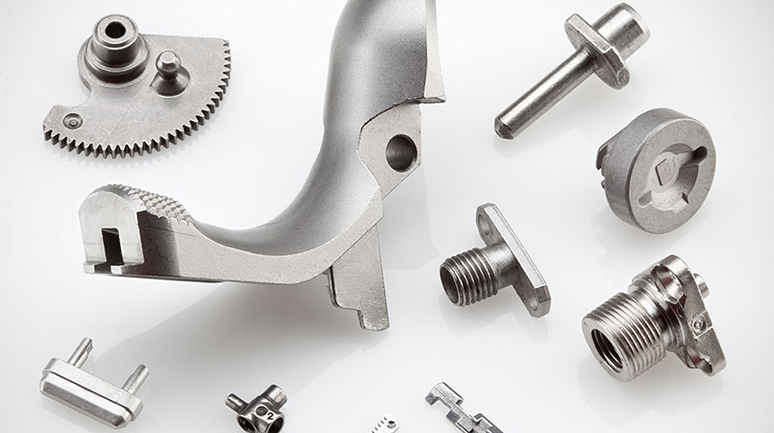
Yes, metal can be injection molded through a process called Metal Injection Molding (MIM). MIM combines the advantages of powder metallurgy and plastic injection molding to produce complex, high-precision metal parts. Here’s a detailed overview of metal injection molding:
What is Metal Injection Molding (MIM)?
Metal Injection Molding (MIM) is a manufacturing process used to produce metal parts with intricate shapes and high precision. It involves mixing fine metal powders with a binder material to create a feedstock, which is then injected into a mold to form a green part. The green part undergoes debinding to remove the binder and is then sintered to produce a dense, solid metal part.
Steps in the MIM Process
- Feedstock Preparation:
- Fine metal powders are mixed with a binder (typically a combination of polymers and waxes) to create a homogeneous mixture known as feedstock.
- Injection Molding:
- The feedstock is heated and injected into a mold cavity using an injection molding machine, forming the desired shape. The resulting part, known as the green part, is still held together by the binder.
- Debinding:
- The binder is removed from the green part through a process called debinding. This can be done using solvents, thermal processes, or a combination of both. The part after debinding is called a brown part.
- Sintering:
- The brown part is heated to a temperature below the melting point of the metal in a controlled atmosphere furnace. During sintering, the metal particles fuse together, increasing the part’s density and strength.
- Post-Processing:
- Additional processes such as machining, heat treatment, surface finishing, and inspection may be performed to achieve the final specifications and properties.
Advantages of Metal Injection Molding
- Complex Geometry:
- MIM can produce parts with intricate geometries and fine details that would be difficult or impossible to achieve with traditional metalworking methods.
- High Precision:
- The process allows for tight tolerances and high dimensional accuracy, making it suitable for precision components.
- Material Properties:
- MIM parts retain the desirable properties of the metal, including high strength, hardness, and thermal and electrical conductivity.
- Material Efficiency:
- The process generates minimal waste compared to traditional machining, as the feedstock can be reused.
- Cost-Effective for High Volumes:
- MIM is economically viable for producing large quantities of small to medium-sized parts, particularly when complex shapes are required.
Applications of Metal Injection Molding
- Automotive Industry:
- Engine components, transmission parts, sensors, and connectors.
- Medical Devices:
- Surgical instruments, orthopedic implants, and dental tools.
- Electronics:
- Connectors, housings, and micro-mechanical components.
- Consumer Products:
- Eyewear frames, watch components, and hardware tools.
- Aerospace:
- Structural components, fasteners, and intricate parts requiring high precision and performance.
[elementor-template id=”4330″]
Considerations in Metal Injection Molding
- Material Selection:
- The choice of metal powders is crucial for achieving the desired properties. Commonly used metals include stainless steel, titanium, cobalt-chrome, and various alloys.
- Part Size and Complexity:
- MIM is particularly suitable for small, complex parts. Large parts may be challenging due to limitations in the molding and sintering processes.
- Cost:
- While MIM is cost-effective for high-volume production, the initial tooling and material costs can be high, making it less suitable for low-volume production runs.
- Shrinkage:
- Significant shrinkage occurs during sintering (typically 15-20%), which must be accounted for in the mold design to ensure final part accuracy.
Conclusion
Metal Injection Molding (MIM) is a versatile and efficient manufacturing process for producing complex, high-precision metal parts. It combines the benefits of plastic injection molding and powder metallurgy, offering a cost-effective solution for high-volume production of intricate metal components across various industries. By carefully managing the materials, processes, and design considerations, MIM can achieve high-quality parts with excellent mechanical properties and intricate geometries.
Related Conten: Injection Mold Manufacturing
 DTG Mould Trade Process |
|
| Quote: | According to sample, drawing and specific requirement. |
|---|---|
| Discussion | Mold material, cavity number, price, runner, payment, etc. |
| S/C Signature | Approval for all the items. |
| Advance | Pay 50% by T/T |
| Product Design Checking | We check the product design. If some position is not perfect, or can not be done on the mould, we will send customer the report. |
| Mold Processing | Send report to customer once each week |
| Mold Testing | Send trial samples and try-out report to customer for confirmation |
| Mold Modification | According to customer’s feedback. |
| Balance Settlement | 50% by T/T after the customer approved the trial sample and mould quality. |
| Delivery | Delivery by sea or air. The forwarder can be designated by your side. |
 |
|

